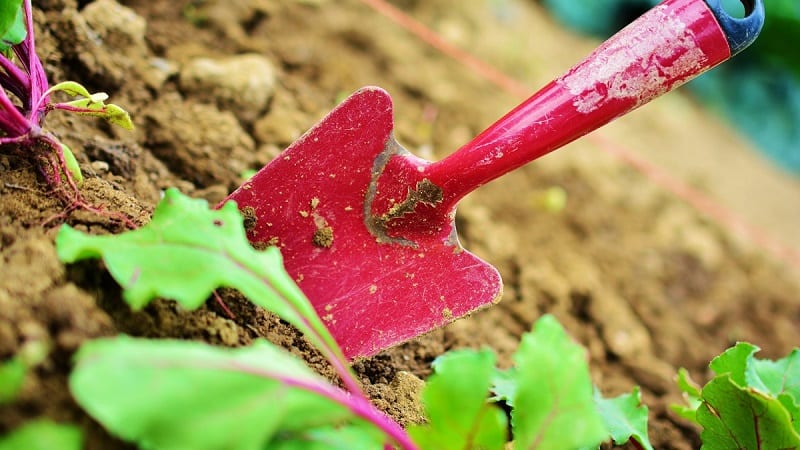Last Updated on August 12, 2024 by teamobn
Researchers have long warned that the agricultural practice of tilling the ground before planting disrupts the delicate ecosystem that sustains healthy soil. Digging upends the network of microorganisms, insects, worms, and soil layers that keeps soil productive.
This explains the popularity of double-dig garden beds. Double-dig gardening usually involves building atop the soil, as is, so that it maintains its natural structure.
As a remedy for nutrient-deprived, dry, and highly compacted soil, no-dig methods require time – sometimes years – to work.

The Double-Dig Approach
Contents
Double-digging is an alternative approach. The method involves loosening problematic soil just enough for immediate planting. The basic goal is the creation of an extra deep bed of loose, amended soil without inverting the soil layers.
Double digging is so-called because you dig to a depth of approximately two spading forks. The practice requires more work at the outset than tilling. In a garden with highly compacted soil, you’re likely to feel like you’re trying to dig to China.
When done correctly, however, you only have to do it once. Here’s how:
Step-by-Step Double-Dig Garden Bed
- Drive four stakes into the ground, forming the corners of a rectangle to mark the area of the bed. Four feet is the maximum width that allows easy access to the middle of the bed. Remove existing vegetation from the area.
- Dig a 12-inch wide trench about 8 inches deep in one end of the designated bed. Set aside the excavated soil in a wheelbarrow.
- Push a digging fork as deep as possible into the bed and then rock it back and forth to gently loosen the soil. Spread a few inches of compost in the bottom of the trench, working it into the soil using the same technique. Do not turn the soil over.
- Dig another a 12-inch wide trench in the adjacent section of the bed. Use the excavated soil to fill the first trench. Loosen the soil at the bottom of the second trench and enrich it with compost using the same technique.
- Repeat this process until you have loosened the topsoil of the entire bed. Use the soil from the first trench – still waiting in your wheelbarrow – to fill the last trench left at the end.
- Spread a layer of compost over the completed bed. Mulch vigorously to suppress weeds and improve soil moisture. Then rake the bed into an even surface for planting.

(Photo: Staff Sgt. Mike Meares/US Air Force)
Pros and Cons
Double-dig garden beds are a traditional method that deeply aerates the soil, preparing it for planting without disturbing its natural layers. This technique has gained traction among gardeners who wish to improve soil conditions while minimizing ecological disruption. Here, we’ll explore the advantages and disadvantages of adopting the double-digging garden bed method.
Pros of Double-Digging Garden Bed
- Improved Soil Aeration and Drainage: A double-dig garden bed mostly helps with soil aeration and drainage. Double-digging lets roots reach further into the ground, so accessing more nutrients and water by loosening the soil up to two spade depths. In places with heavy, compacted soils especially, this can be quite helpful.
- Increased Root Growth: Double-dig garden beds help to produce great root development. Plants can extend their roots farther down by building a larger area of loosened soil, so stabilising them and improving their access to water during dry spells. For deep-rooted plants to grow properly, this is absolutely crucial.
- Enhanced Soil Fertility: Improved soil fertility can result from including organic matter, such compost, into the lowest layers of soil. A double-digging garden bed guarantees the even distribution of organic additions far down into the soil, so giving plants long-term nutritional advantages.
Cons of Double-Digging Garden Bed
- Labor Intensity: One of the major drawbacks of the double-dig garden bed method is the significant amount of physical labor required. The process involves manually digging and moving large volumes of soil, which can be strenuous and time-consuming.
- Potential for Soil Disruption: Although double-digging is less invasive than full-scale tilling, it can still disrupt soil ecosystems to some extent. The technique may disturb the habitats of beneficial soil organisms, which play crucial roles in nutrient cycling and disease suppression.
- Not Suitable for All Soil Types: In some cases, double-digging may not be appropriate, particularly in very sandy or clay-heavy soils. In sandy soils, the loosened structure may lead to increased water drainage, potentially drying out the soil too quickly. Conversely, clay soils may become too compacted if improperly managed after double-digging.
While the double-digging garden bed approach offers numerous benefits such as improved drainage, root growth, and soil fertility, it also comes with challenges like high labor intensity and potential soil disruption. Gardeners considering this method should weigh these factors based on their specific garden conditions and capabilities.
Comparison with Traditional Tilling Methods
Double-digging garden beds offer a distinct approach to soil preparation, contrasting significantly with traditional tilling methods. While both strategies aim to improve soil conditions for better plant growth, their impact on the garden’s ecosystem and long-term soil health varies. This section explores how the double-dig garden bed method compares to conventional tilling, highlighting the differences that might influence a gardener’s choice.
Soil Structure Preservation
- Double-Dig Garden Bed: The double-dig garden bed technique is meticulous about maintaining the natural layering of the soil. By avoiding the complete inversion of soil layers, this method helps preserve the existing microbial ecosystems and minimizes disruption to earthworm habitats, which are vital for natural soil aeration and nutrient cycling.
- Traditional Tilling: In contrast, traditional tilling often involves turning over the soil to a depth of 6-12 inches, completely inverting the soil layers. This can disrupt the natural soil structure, destroy microbial habitats, and bring dormant weed seeds to the surface, potentially leading to increased weed problems.
Impact on Soil Health
- Double-Dig Garden Bed: Double-digging enhances soil health by aerating the deeper layers without disrupting the topsoil’s organic matter. This method allows for better water infiltration and root penetration, which are essential for healthy plant growth. The careful handling of soil layers also helps in maintaining the soil’s organic content, which is beneficial for long-term fertility.
- Traditional Tilling: Traditional tilling can degrade soil health over time by exposing organic matter to air, which accelerates decomposition and reduces the soil’s ability to retain moisture and nutrients. Frequent tilling can lead to soil compaction and erosion, particularly in areas with loose topsoil.
Labor and Time Investment
- Double-Dig Garden Bed: Although initiating a double-dig garden bed requires considerable effort and time, this is mostly a one-time investment. Once established, the bed only needs minimal disturbance in subsequent years, reducing the workload over time and maintaining soil integrity.
- Traditional Tilling: Traditional tilling might seem less labor-intensive initially but often needs to be repeated annually, which can be more demanding in the long run. This repeated disturbance not only increases labor but can also lead to compaction and other soil health issues, requiring additional efforts to amend and manage the soil.
Suitability for Different Soil Types
- Double-Dig Garden Bed: Double-digging can be adapted to various soil types, from heavy clay to loose sandy soils, with appropriate amendments like compost or sand incorporated during the digging process. This flexibility makes double-digging a versatile option for many gardeners.
- Traditional Tilling: While effective in many settings, traditional tilling can exacerbate problems in specific soil types. For instance, tilling sandy soils can reduce their ability to retain moisture, whereas clay soils might become more prone to compaction and waterlogging.
The double-dig garden bed method offers several advantages over traditional tilling by better preserving soil structure, enhancing soil health, and requiring less annual labor. These benefits make it an attractive option for gardeners looking to establish a sustainable and productive garden.

Challenges and Common Mistakes
While the double-dig garden bed method has numerous benefits, it’s not without its challenges and common pitfalls. Understanding these potential issues can help gardeners avoid common mistakes and ensure the success of their double-dig garden beds.
Misjudging Soil Conditions
- Challenge: One of the primary challenges with establishing a double-dig garden bed is accurately assessing the existing soil conditions. This method requires a good understanding of the soil’s texture, moisture level, and overall health. Incorrect assessment can lead to inappropriate soil amendments or digging at the wrong time, which can adversely affect plant growth.
- Common Mistake: Gardeners might dig when the soil is too wet or dry, which can damage its structure. It’s crucial to perform the double-digging process when the soil is moist but not saturated, ensuring the best conditions for loosening and aerating without causing compaction or clumping.
Overworking the Soil
- Challenge: Double-digging involves a careful balance of soil disturbance. While the aim is to loosen the soil and improve its structure, excessive or overly aggressive digging can actually harm more than help, particularly in sensitive soils.
- Common Mistake: Overworking the soil during the double-dig process can disrupt the existing microbial ecosystems more than necessary. It’s important to limit soil disturbance to the necessary depth and avoid turning the soil layers upside down.
Underestimating Labor Intensity
- Challenge: The labor intensity of establishing a double-dig garden bed is often underestimated. This method is more physically demanding than many other garden bed preparations due to the depth and extent of digging required.
- Common Mistake: Gardeners may not allocate enough time or physical resources to properly complete a double-dig garden bed, leading to incomplete or improperly prepared beds that do not offer the full benefits of this method.
By addressing these challenges and avoiding these common mistakes, gardeners can effectively establish a double-dig garden bed that promotes healthy plant growth and enhances the overall productivity of their garden.
Conclusion
The double-dig garden bed method stands out as a robust alternative to traditional tilling, offering deeper soil aeration and improved plant root development. While it requires an initial investment of labor, the long-term benefits include enhanced soil health and reduced maintenance. Ultimately, this method provides a sustainable solution for gardeners seeking to optimize their garden’s productivity and ecological balance.








